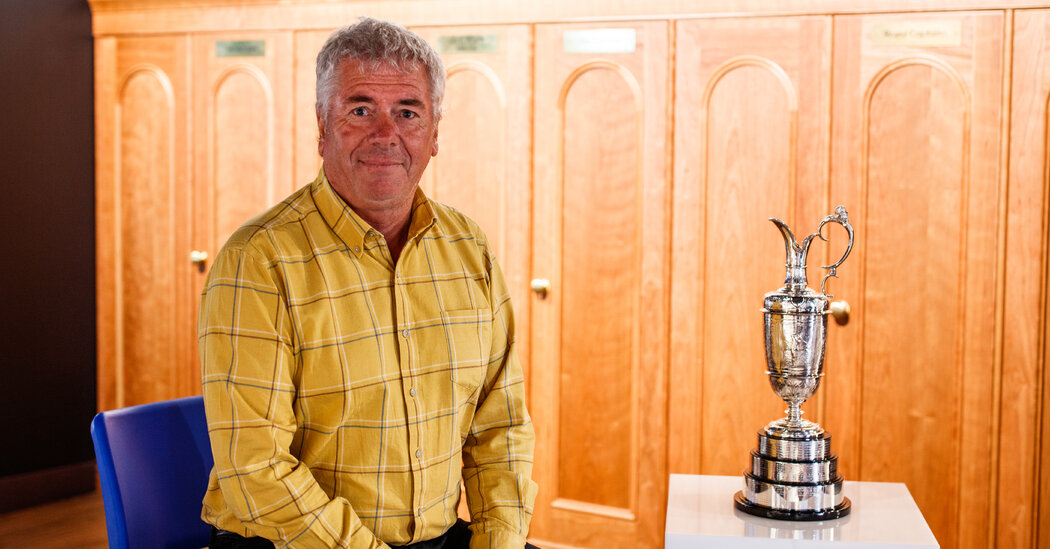
ST. ANDREWS, Scotland — The good news for Garry Harvey is that almost no one in this year’s British Open field has a name quite as long as Severiano Ballesteros — Spanish master of the short game, three-time Open champion and unwitting menace to a man with minutes to engrave one of golf’s most sacred trophies.
Harvey will face a foreboding stretch on Sunday anyway. Like his father, Alex, who was tasked with etching Ballesteros into history on deadline, he will have perhaps 10 minutes to add Rory McIlroy (11 letters) or Padraig Harrington (17 letters) or someone else entirely to the claret jug.
He will fret over spelling. He will fuss over spacing. For engraving efficiency as much as national pride, he would not have minded if the Scot Paul Lawrie had won again. But he began engraving when he was 14, has handled claret jug duties since Tony Blair was prime minister and has a large enough reservoir of on-demand tranquillity that he played in the 1979 Open, one of three that Ballesteros won, forcing Alex Harvey to add the Spaniard’s name to the jug instead of his son’s.
“When I get nervous, I remember what my father looked like and taught me,” Garry Harvey, 67 and soft-spoken, said along the Old Course at St. Andrews, the site of the 150th Open. “When I’m under pressure, I think about the old man, and then I just do it.”
And so a letter, Harvey said, might take him eight seconds to add to a band on the jug’s base.
Generations of Open winners handled the engraving of the jug, which is formally known as the Golf Champion Trophy. But after Roberto De Vicenzo, the 1967 victor at Royal Liverpool, failed to do so, the R&A, the Open’s organizer, took control and turned to Alex Harvey. Garry Harvey, born months after Peter Thomson won the first of his five Opens, began his engraving education around then.
At the same time, he was emerging as one of Britain’s best young golfers, finishing as the runner-up at the boys’ amateur championship in 1971 and winning the following year. He put his own name on the trophy in the most literal sense, too.
Other golf achievements followed, including a victory at the 1985 Kenya Open and a berth in an Open at Royal Lytham & St Annes, where he finished in a tie for 139th. All the while, Alex Harvey’s hands were evolving into a fixture of television coverage of the Open.
Garry Harvey would often accompany his father, scrutinizing his patience and practices. Alex Harvey did not, for example, start adding Jean van de Velde’s name when he arrived at No. 18 at Carnoustie in 1999 with the three-shot lead that he soon squandered. He always waited for word from the leader of the R&A that the score was final.
Now Garry Harvey, whose father died in 2008, a few years after retiring, has been around the Open so long that he cannot remember exactly whose name he was first charged with engraving.
Even if the current craftsman typically prefers to work in the background, the ritual is seen as an element of the Open’s charm. Tom Watson, whose eight major victories include five British Open wins, said that rapid engraving had grown to become “part of the whole fabric of the Open Championship.”
“It really doesn’t matter whether your name is on the trophy or not, honestly — you have the trophy in hand and you get to see that beautiful claret jug — but it’s a perk,” Watson, one of the first winners to raise a freshly updated trophy, said on Friday. “It’s a great perk.”
In turn, Harvey has a well-settled practice for the final round, preparing certain parts of the engraving, like the tournament’s site and year, in advance. But he also avoids venturing onto the course on Sunday, rife with hazards — crowds, nerves, fall risks — that could conspire to keep him from being at his position when the minute comes. He mutes the television, uninterested in the commentary about his hands, and does not care for the clicks of a still camera’s shutter. He hopes a floorboard does not shake and interrupt his rhythm and concentration as he works with a tool he believes is at least a century old.
“There are all types of things that can go wrong, but the spelling’s important,” he said. “You don’t want to slip, and that can’t happen.” (“The spelling of Padraig, you’ve got to be very careful with that one,” he said, referring to the Irish golfer whose name he has twice added to the jug.)
The Open gig, of course, is a fraction of his work, which often brings other sports trophies and medals to his work area, whether it is at St. Andrews or closer to his home in Crook of Devon, a village about an hour’s drive from the Old Course. Along with his wife, Jeanette, he runs a jewelry shop in nearby Dunfermline, where it seems only a few customers know that he works on the jug.
He expects to work with the R&A for as long as he can, and there is no prospect, he said, of another family member assuming the role.
He will, eventually, get around to watching a replay of Sunday’s round. He has plans for Monday, though: a Senior Open qualifier. But before then, until the etching is done, he will wait and wonder what, exactly, he will need to do almost as soon as the last putt drops.
“If it’s a long name — a really long name — it’s going to be tricky,” he said.
He reassured himself, his voice trailing off.
“If Severiano Ballesteros can get into that gap.”